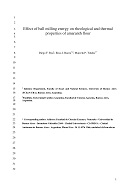Please use this identifier to cite or link to this item:
https://repositorio.uca.edu.ar/handle/123456789/5416| Título: | Effect of ball milling energy on rheological and thermal properties of amaranth flour | Autor: | Roa, Diego F. Baeza, Rosa Tolaba, Marcela P. |
Otros colaboradores: | Universidad de Buenos Aires (Argentina). Facultad de Ciencias Exactas y Naturales Universidad Católica Argentina (Buenos Aires). Facultad de Ciencias Agrarias |
Palabras clave: | AMARANTO; VISCOSIDAD; MOLIENDA; ALMACENAMIENTO | Fecha de publicación: | 2015 | Cita: | Roa, D.F., Baeza, R.I. y M.P. Tolaba. 2015. Effect of ball milling energy on rheological and thermal properties of amaranth flour [en línea]. Preprint del artículo publicado en Journal of Food and Technology. DOI 10.1007/s13197- 015-1976-z Disponible en: https://repositorio.uca.edu.ar/handle/123456789/5416 | Resumen: | Abstract: Pearled amaranth grains obtained by abrasive milling were processed by planetary ball milling to produce starch-enriched flours. The influence of milling energy on rheological and thermal behavior of starch-enriched amaranth flour dispersions and stability during refrigerated storage was investigated. The rheological behavior of flour dispersions was determined using a rotational viscometer, while enthalpy change was determined by differential scanning calorimetry. The power law model was found to be suitable in expressing the relationship between shear stress and shear rate. All flour dispersions showed a pseudoplastic behavior. However this character decreased with the storage being dependent on flour concentration and milling energy. Several characteristics of the flour dispersions could be explained: decrease of the consistency coefficient and increase of the flow index with the increasing milling energy; decrease of gelatinization enthalpy showed the loss of crystalline structure due to ball milling, as well as increased stability of the flour dispersions during storage. It was observed, that the stability changed with the concentration of amaranth flours. Thus, more stable dispersions were obtained as the flour concentration increased. The highly milled sample was the most stable sample during the storage. To conclude, a more suitable performance to develop liquid food could be obtained using modified amaranth flour by the application of ball milling procedure | URI: | https://repositorio.uca.edu.ar/handle/123456789/5416 | Disciplina: | INGENIERIA EN ALIMENTOS | Derechos: | Acceso Abierto | Fuente: | Preprint del artículo publicado en Journal of Food Science and Technology, julio 2015 |
| Appears in Collections: | Artículos |
Files in This Item:
| File | Description | Size | Format | |
|---|---|---|---|---|
| effect-ball-milling-energy.pdf | 359,83 kB | Adobe PDF |  View/Open |
Page view(s)
132
checked on Apr 30, 2024
Download(s)
153
checked on Apr 30, 2024
Google ScholarTM
Check
This item is licensed under a Creative Commons License

